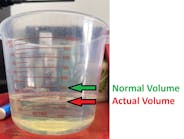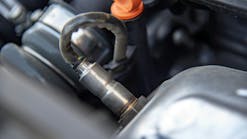Tool comparison: Choosing the right tool for diagnosing a MAF sensor issue
Vehicles affected: All
Issue: Mass Air Flow (MAF) fault diagnosis
Tools used:
- Vehicle information source
- Scan tool
- Lab scope
In the April 2016 Tool Briefing, we discussed how choosing the correct tool can save valuable time by allowing you to obtain a quick and accurate diagnosis. In that issue, we compared diagnosing an oxygen sensor issue using a DMM, a waveform viewer, a scan tool and a lab scope. This month we will be comparing the use of a scan tool and a lab scope to diagnose a mass air flow (MAF) problem.
Obtain vehicle system information
In order to understand both the diagnostic process and the value of any tool, it is necessary to understand how the system works and what, if any, other components are related to the system you are working on. Along with system operation information and specifications, check for technical service bulletins (TSBs) that pertain to the specific vehicle. TSBs can be issued for common failures such as a wiring repair, an updated component, or in some cases, a reprogram of the PCM.
By far the best resource for this information will be within a repair information database such as Identifix Direct-Hit. Information necessary to understand the specific operating parameters on the vehicle you are working on are typically found in the “system and operation” category.
How other sensors are utilized in a system to verify system operation or are used in a calculation of another sensor’s value should also be researched. If any codes are present, it is also very helpful to obtain the specific component operating conditions required to set the code. This data is also found in your repair database.
The system: A background on the MAF sensor
Generally speaking, the MAF sensor is the primary data input to the vehicles’ fuel management system to calculate how much air is entering the engine. This allows the management system to provide the correct amount of fuel by varying the fuel injector pulse width, or injection timing, to match the amount of air entering the engine. Knowing how much air is entering the engine, the PCM is able to calculate the correct air/fuel ratio under all conditions.
Another factor used to determine fuel need is engine load. Air flow combined with throttle angle and RPM determine engine load. The PCM uses engine load to calculate the amount of fuel required to maximize performance, fuel economy and operate within the emission parameters for the vehicle at all times.
To simplify the technology used by most MAF sensors, a heating wire or film element is placed within the sensor to heat and maintain the element to a specific temperature above ambient air temperature. As air flows across the sensing element the amount of current used to maintain the specific temperature is measured to determine the quantity of air entering the engine. In essence, more air flowing across the sensor will cause it to cool and it will need more current to heat the sensor back to the required temperature.
Current is measured and calculated to determine the amount of air flowing across the sensor. Because the MAF sensor is heating the element to a specific temperature above ambient air the PCM needs to know what the ambient air temperature is in order to set the heated temperature target.
Tool No. 1: Diagnosis with a scan tool
Start with obtaining any fault codes and look at freeze frame data associated with any codes that are present. Remember, some scan tools will default to providing freeze frame data for the first code, or the highest priority code, that was recorded. With that in mind, make sure the freeze frame data is for your specific code.
Fault codes related to MAF sensors can be either performance-related due to higher or lower current than expected, or they can be codes for a MAF heater circuit caused by an open or short.
Other codes that can be related to MAF sensor issues include lean or rich fuel delivery. These can be due to a MAF sensor over- or under-reporting the amount of air entering the engine. Additional issues can be due to mechanical engine problems such as exhaust restrictions not allowing exhaust to escape and causing it to back up into the intake system, restricting fresh air from entering the intake.
Armed with any codes, follow the recommended fault tree for diagnosis and the wiring diagram to verify proper supply voltage and ground circuit integrity to the sensor and heater.
If there are no specific MAF fault codes but you suspect the sensor may be the reason of a rich or lean condition, it will be necessary to observe MAF readings while operating the vehicle under different conditions.
At idle, observe the PID for MAF GPS (grams per second). The widely-accepted specification for this is approximately 1 gram per liter of engine size; meaning a 2.0L engine should read around 2 GPS, a 3.8L engine should be around 3.8 GPS, and so on.
Remember we are speaking in generalities in this article. Due to some newer technologies, such as variable valve timing, intake runner control or some GDI engines that do not have a throttle plate, it is mandatory to check the specifications for the exact vehicle you are working on and use those specifications to diagnose the system.
Some vehicle manufacturers provide specifications for GPS at specified RPM. Using information obtained from Identifix, raise the engine speed to the specified RPM ranges and observe the MAF GPS at the RPM listed. Compare your readings with those obtained from your database Readings— within 10 percent are generally acceptable. If there are small discrepancies, look for contamination on the sensor.
There are some approved cleaners on the market, such as CRC MAF sensor cleaner, that are safe to use for both MAF and oxygen sensors. Other cleaners, such as carb or brake cleaners, can damage the sensing film and should be avoided. Cleaners may work if the contamination has not baked onto the sensing element. If the contamination has baked on, the sensor will need to be replaced.
Use your scan tool to verify operation of other sensors the PCM uses to calculate load and air flow. PIDs for throttle angle and rpm should be checked to verify they are within range and are transitioning smoothly while operating the throttle. Both throttle angle and rpm are used to calculate load so it is critical they are reporting accurately.
Remember to only look at a few PIDs at a time, because the update rate of the scan tool is diminished when you are monitoring multiple PIDs.
Because the MAF is maintaining a heated temperature above ambient air, it is necessary to verify the ambient, or outside, air temperature is measuring properly. Observe the PID to make sure it is reading properly and is not fluctuating. This PID may be listed as “Intake Air Temperature” on the scan tool.
A useful feature of your scan tool is the graphing feature. You can use it to graph and monitor the MAF sensor to see if is making smooth transitions as engine RPM is varied up and down, and maintaining a stable reading at any steady RPM. You can also graph MAF, throttle angle and engine RPM to make sure they all correlate as engine speeds change.
We discussed briefly how load affects fuel delivery, and we know that the PCM calculates load using the MAF sensor. Either mechanical engine issues or faulty MAF readings can cause incorrect load values affecting both fuel delivery and performance.
By using the Calculated Load PID on your scan tool, it is relatively easy to determine if it is more likely you have a mechanical or a MAF sensor issue.
Start by warming the engine to normal operating temperature. To be safe, either have an assistant drive the vehicle while you are observing the scan tool readings, or use the record feature on your tool. Accelerate quickly to wide open throttle (WOT) and note the calculated load value and Short Term Fuel Trim (STFT) values.
Normal load values for a naturally aspirated engine are in the 80 to 90 percent range at WOT. This reading equates to how efficiently air is entering and leaving the engine. If readings are higher than 90 percent or lower than 80 percent, it means either the MAF is misreporting the amount of air entering the engine, or there is a mechanical condition causing a restriction in either the intake or exhaust system.
If the load value is out of range, look at the STFT reading. If it is normal, it means the PCM is delivering the correct amount of fuel matching the amount of air that is entering the engine. It is likely the incorrect load value is caused by a mechanical issue which is restricting air flow and the MAF is correctly reading the amount of air entering the system.
If the load value is incorrect and the STFT value is also correcting fuel by a large amount (over or under 20 percent), then it is likely the MAF is not reporting the amount of air correctly and the PCM is having to make fuel corrections to compensate for varying amounts of air reported by the MAF.
Another way to calculate this is by using a VE (Volumetric Efficiency) calculator formula and entering MAF, IAT and RPM readings from your scan tool. A VE calculator formula can be found at https://www.otctools.com/ve.
Tool No. 2: Diagnosis with a lab scope
Utilizing a lab scope for diagnosing most automotive sensors is in many cases the preferred method. A lab scope will provide a real-time visualization of what the sensor is doing based on changes at the time they occur.
For example, you can correlate the signal from a MAF sensor compared to throttle angle and engine rpm to make sure they all respond in the same fashion as engine speed changes. You are able to monitor these same changes with the graphing function of your scan tool with some limitations of how quickly the tool updates.
The advantage of a lab scope is it allows you to designate the exact time and voltage scales you are using to observe the graphs, possibly giving you the ability to capture glitches you cannot see with a scan tool.
While observing a lab scope pattern, you can see if the response time is reacting quickly to inputs such as throttle position during a snap throttle test. You are also able to monitor the pattern for “noise,” marked by hash lines, indicating turbulence or erratic sensor operation. The hash lines represent small variations in the signal that can be an indicator of small voltage differences or minor changes in the signal. An example of a minor change in the MAF reading could be a sticking valve causing a pulsation in the air intake stream. This would translate to a small hash line in the voltage signal.
The appropriate tool for this diagnosis
Even though a scan tool and a lab scope will both provide valuable information, using a scan tool will in most cases provide a quicker and complete diagnosis.
This proficiency is accomplished by allowing you to see the multiple PIDs and factors that affect a MAF sensor’s operation much more quickly than testing each individual component with a lab scope.



